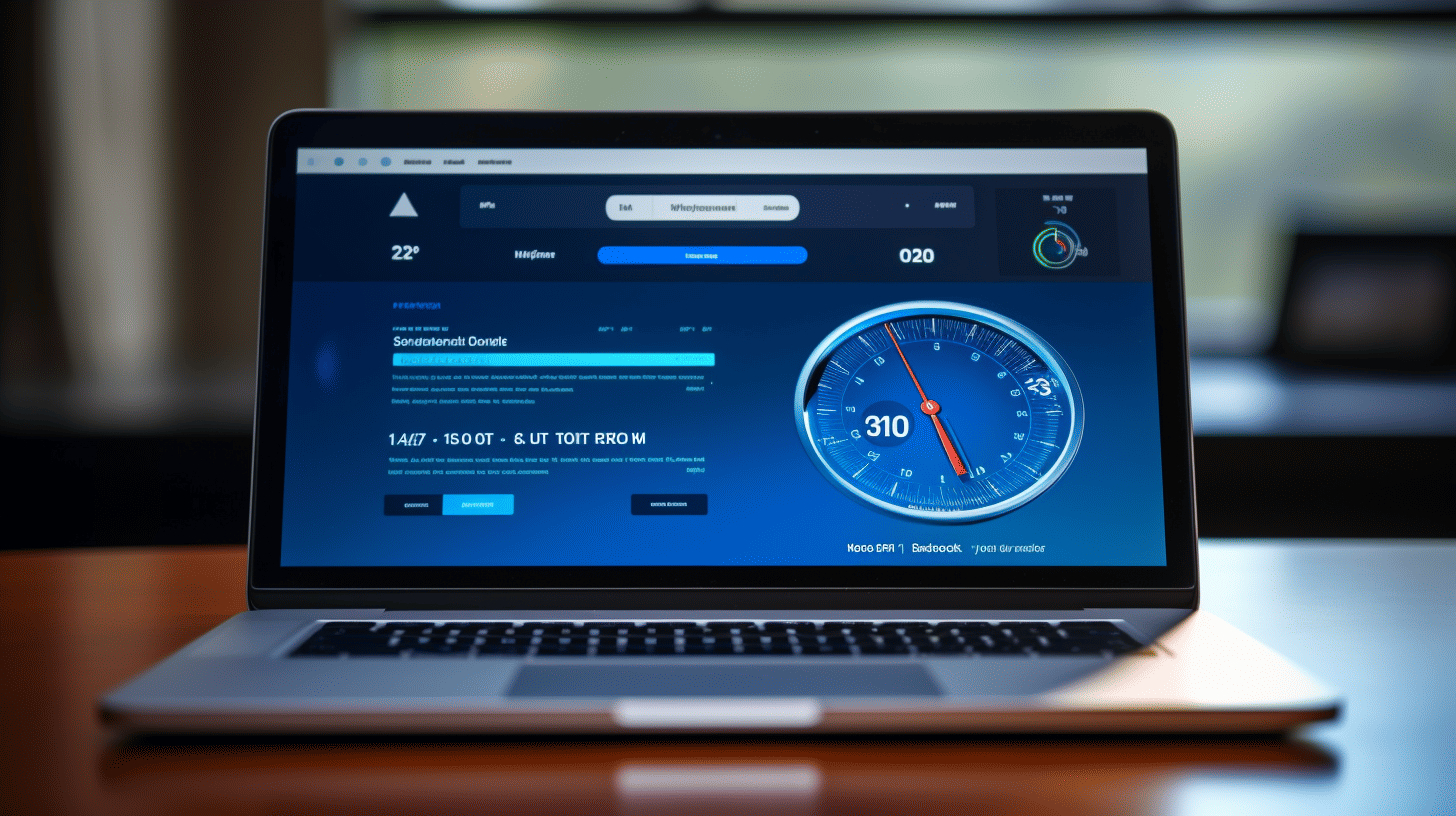在當今快節奏的數位環境中,加載緩慢的網站可能會對您的線上成功造成不利影響。使用者變得越來越沒有耐心,希望網站能夠在眨眼間載入完畢。如果您的 WordPress 網站未能滿足他們的期望,您可能會失去潛在客戶,跳出率更高,並且對您的搜尋引擎排名產生負面影響。
但不要害怕! WordPress 速度優化可以解決這個問題。透過實施各種技術、優化和工具,您可以增強 WordPress 網站的效能並確保閃電般的載入時間。在本綜合指南中,我們將探討 2023 年 WordPress 速度優化的來龍去脈,為您提供寶貴的見解和實用技巧,以增強您網站的效能。
因此,無論您是經驗豐富的 WordPress 專家還是剛剛入門,請加入我們的旅程,解開閃電般快速的 WordPress 速度優化的秘密。讓我們開始吧! 🚀
WordPress 速度優化的重要性
🚀 您是否知道 WordPress 網站的速度會對其成功產生重大影響?這是真的!在當今快節奏的數位世界中,用戶對於加載緩慢的網站幾乎沒有耐心。事實上,研究表明,頁面載入時間僅延遲一秒鐘就會導致轉換率降低 7%。哎呀!這意味著潛在客戶在有機會接觸您的內容或進行購買之前就已經離開。
⏰ 那麼,您可以做些什麼來確保您的 WordPress 網站速度極快呢?答案在於 WordPress 速度優化技術的神奇之處。透過實施這些策略,您可以提高網站的效能,增強使用者體驗,並最終提高成功的機會。讓我們深入了解一些可用於優化 WordPress 網站速度的頂級技術。
1.優化影像
📷 圖像是任何網站的重要組成部分,但大型未壓縮的圖像會顯著減慢網站的載入時間。透過優化圖像,您可以減小其檔案大小而不影響品質。考慮使用外掛程式或線上工具來壓縮圖像,然後再將它們上傳到您的 WordPress 網站。
2. 縮小 CSS 和 JavaScript
📦用於為您的 WordPress 網站設定樣式和添加功能的 CSS 和 JavaScript 檔案可能會變得龐大,並降低您網站的效能。縮小這些檔案包括刪除不必要的空格、換行符和註解以減少其大小。您可以使用 Autoptimize 或 WP Rocket 等外掛程式來自動縮小這些檔案並提高網站的速度。
3.啟用快取
📂 透過儲存網頁的靜態版本,快取可以顯著提高 WordPress 網站的載入時間。當使用者造訪您的網站時,伺服器可以提供快取版本,而不是從頭開始動態產生頁面。這減少了伺服器負載並加快了載入過程。流行的快取插件,例如 W3 Total Cache 和 WP Super Cache,可以讓您輕鬆地在 WordPress 網站上啟用快取。
4.優化資料庫
💽 WordPress 資料庫儲存您網站的所有內容,包括貼文、頁面、評論等。隨著時間的推移,這個資料庫可能會充斥著不必要的數據,從而影響您網站的效能。優化資料庫包括清理未使用的資料、刪除垃圾評論以及優化資料庫表以提高效率。 WP-Optimize 或 Advanced Database Cleaner 等外掛程式可以幫助您簡化此過程。
5. 選擇可靠的託管服務供應商
🌐 您的主機服務供應商的品質對於您的 WordPress 網站的速度和效能起著至關重要的作用。選擇專門從事 WordPress 託管的知名主機服務供應商,並提供具有固態硬碟 (SSD) 和其他效能最佳化的快速伺服器。託管式 WordPress 託管服務提供者(例如 Managed WP)可提供無憂的體驗,並針對優化您網站的速度提供專門的支援。
💨速度很重要。透過應用這些 WordPress 速度優化技術,您可以確保您的網站快速載入、吸引用戶並推動轉換。請記住,在快節奏的網路世界中,分分秒秒都至關重要!因此,今天就開始實施這些策略,讓您的 WordPress 網站獲得應有的速度提升。
📝 想要了解更多關於 WordPress 速度優化技術的資訊嗎?請參閱這份綜合指南: WordPress 速度優化技術.
託管對 WordPress 速度的影響
選擇正確的託管提供者
對 WordPress 來說,速度很重要。網站載入緩慢會導致高跳出率、訪客失望以及搜尋引擎排名下降。影響 WordPress 網站速度的關鍵因素之一是選擇託管該網站的託管服務提供者。
在這裡,我們將討論為您的 WordPress 網站選擇正確的託管服務提供者的重要性,並為像 SiteGround 這樣的快速託管服務提供者提供建議。
託管在 WordPress 速度中的作用
在深入選擇過程之前,了解託管在 WordPress 網站速度中扮演的角色非常重要。您選擇的託管服務提供者將決定:
- 伺服器回應時間:這是伺服器回應訪客瀏覽器的請求所需的時間。伺服器回應時間緩慢會嚴重降低您的網站速度。
- 正常運作時間和可靠性:可靠的主機服務提供者將確保您的網站始終正常運作。頻繁停機會對您的網站的速度和效能產生負面影響。
- 伺服器位置:伺服器的實體位置會影響您網站的速度。選擇伺服器距離目標受眾較近的託管服務提供者可以幫助縮短載入時間。
- 硬體和基礎設施:託管服務提供者使用的硬體和基礎設施的品質會直接影響您網站的速度和效能。
選擇合適的託管服務提供者以提高速度
為您的 WordPress 網站選擇託管服務提供者時,需要考慮以下幾個關鍵因素:
1. 速度和性能
尋找提供快速伺服器和優化基礎架構的託管服務提供者。固態硬碟 (SSD)、內容分發網路 (CDN) 和快取機制等功能可以顯著提高您網站的速度和效能。
2.正常運作時間和可靠性
確保託管服務提供者擁有良好的正常運作時間和可靠性記錄。尋找能夠保證高正常運作時間百分比的供應商,最好是 99.9% 或更高。
3. 伺服器位置
考慮託管服務提供者提供的伺服器位置。如果您的目標受眾主要位於特定地區或國家,請選擇在該地區擁有伺服器的提供者。這有助於減少延遲並縮短訪客的網站載入時間。
4. 客戶支持
當談到託管時,優質的客戶支援至關重要。尋找透過即時聊天、電子郵件和電話等多種管道提供全天候客戶支援的供應商。及時可靠的支援可以幫助解決可能出現的任何問題。
推薦:SiteGround 提供快速 WordPress 託管服務
當談到快速的 WordPress 託管時,一個脫穎而出的提供者是 站點地面。 SiteGround 提供了一系列專門針對 WordPress 最佳化的託管解決方案,具有顯著的優勢,包括:
- 由於採用了固態硬碟 (SSD) 和 NGINX 網路伺服器技術,載入時間極快。
- 全球有多個伺服器位置,讓您選擇最靠近目標受眾的伺服器。
- 一流的客戶支援,全天候提供,幫助您解決任何與託管相關的疑問或問題。
- 尖端的安全功能可保護您的網站免受威脅和漏洞的侵害。
選擇 SiteGround 作為您的主機服務供應商,您可以確保您的 WordPress 網站託管在可靠且高效能的平台上,從而縮短載入時間並全面改善使用者體驗。
請記住,當涉及 WordPress 速度時,託管起著至關重要的作用。選擇合適的託管服務提供者,優先考慮效能、可靠性和卓越的客戶支持,以提高您的網站速度並為您的訪客提供無縫的瀏覽體驗。
首頁優化
歡迎來到首頁優化的世界! 🎉
您的主頁通常是訪客對您網站的第一印象。它就像你虛擬房子的前門,歡迎人們進來。這就是為什麼優化您的主頁以確保它吸引註意力、傳達正確的訊息並鼓勵用戶進一步探索至關重要。
但要從哪裡開始呢?別擔心,我們會保護你的。在本文中,我們將引導您了解一些關鍵策略和最佳實踐,以優化您的主頁並獲得最大的效果。
1. 清晰且引人注目的標題
標題是訪客進入您的主頁時首先看到的內容。它應該引人注目、簡潔並清楚地傳達您的網站內容。以下是創建吸引人的標題的一些技巧:
- 保持簡短、活潑,最好不要超過 10 個字。
- 使用強而有力的、行動導向的語言來引起目標受眾的共鳴。
- 突顯您的產品或服務的主要優勢或獨特賣點。
- 使用較大的字體或增加強調效果,使其具有視覺吸引力。
請記住,您的標題應該立即吸引訪客的注意力並吸引他們進一步探索。
2.引人入勝的視覺效果
人類是視覺動物,在主頁上加入引人注目的視覺效果可以顯著影響用戶參與。以下是優化主頁視覺效果的方法:
- 使用與您的品牌和您想要傳達的訊息相符的高品質圖像。
- 結合影片或動畫來展示您的產品、說明其功能或講述您的品牌故事。
- 優化圖像尺寸以確保快速的載入時間。
- 在您的圖像中添加替代文字以提高可訪問性和 SEO。
迷人的視覺效果不僅可以增強主頁的整體美感,還可以創造令人難忘且身臨其境的使用者體驗。
3. 清晰的導航
結構良好且直觀的導航選單可以讓訪客輕鬆地在您的網站上找到他們想要的內容。以下是一些最佳做法:
- 保持導航選單簡單整潔,僅突出顯示最重要的頁面。
- 對每個選單項目使用清晰且描述性的標籤。
- 包含搜尋欄,讓使用者更輕鬆地找到特定內容。
- 優化您的行動裝置導航,以確保在所有螢幕上獲得無縫體驗。
透過提供清晰的導航選項,您可以幫助用戶輕鬆瀏覽您的網站並找到他們需要的資訊。
4. 戰略號召
號召性用語 (CTA) 是一種提示,鼓勵訪客採取特定操作,例如註冊新聞通訊、請求演示或進行購買。以下是優化 CTA 的一些技巧:
- 使用有說服力的語言清楚傳達採取行動的好處。
- 使用對比色或按鈕,讓您的 CTA 突出且視覺上獨特。
- 將 CTA 策略性地放置在您的主頁上,例如在主標題下方或某個部分的末尾。
策略性 CTA 可以引導訪客採取所需的行動,最終提高轉換率並推動業務成長。
5.社會認同與推薦
人們傾向於相信他人的觀點和經驗。在您的主頁上加入社會證明和推薦可以幫助建立信任和信譽。考慮以下策略:
- 顯示滿意客戶的正面評論、評分或推薦。
- 展示您曾合作過的公司的可識別徽標或媒體對您業務的報導。
- 包括突出您的成就或行業專業知識的統計數據或數據。
透過展現社會認同,您可以向訪客灌輸信心並讓他們相信您的產品或服務值得探索。
請記住,優化您的主頁是一個持續的過程。持續分析使用者行為,執行 A/B 測試並進行資料驅動的調整,以確保您的主頁始終處於最佳狀態。
現在您的工具包中已經有了一些有價值的策略,是時候增強您的主頁並給您的訪客留下持久的印象了。準備,設置,優化! 💪
如果您想深入了解加快網站載入速度的方法,請查看以下綜合指南: 加快網站載入速度.
快取插件的使用
在當今快節奏的網路世界中,網站速度對於用戶體驗和搜尋引擎排名起著至關重要的作用。網站載入緩慢會導致訪客感到沮喪並增加跳出率。這時快取外掛就可以派上用場了!這些方便的工具可以透過快取頁面的靜態版本、減少伺服器負載以及更快地向用戶提供內容來提高網站的效能。
讓我們仔細看看三種流行的快取插件,它們可以顯著提高您的 WordPress 網站的速度和效能。
WP火箭
🔥 WP Rocket 是一款頂級快取插件,以其初學者友好的介面和強大的快取功能而聞名。只需點擊幾下,您就可以啟動此外掛程式並立即提高網站的載入速度。 WP Rocket 的一些突出特點包括:
- 頁面緩存:WP Rocket 會自動建立您網站的靜態 HTML 頁面,以便訪客快速取得。
- 文件優化:此外掛程式可以縮小並合併您的 CSS 和 JavaScript 文件,減少 HTTP 請求的數量並縮短載入時間。
- 資料庫最佳化:WP Rocket 可以清理和優化您的 WordPress 資料庫,進一步增強您網站的效能。
- 延遲載入:透過啟用延遲加載,WP Rocket 僅在用戶向下滾動頁面時加載圖像和視頻,從而節省頻寬並改善初始頁面加載時間。
W3 總緩存
⚡ W3 Total Cache 是一種廣泛使用的快取插件,它提供了廣泛的選項來優化您網站的效能。它具有多種功能,可顯著加快您的網站速度並改善其整體用戶體驗。 W3 Total Cache 的顯著特徵包括:
- 頁面緩存:與 WP Rocket 類似,W3 Total Cache 產生靜態 HTML 頁面以最大限度地減少伺服器請求並減少頁面載入時間。
- 縮小:此外掛程式可以縮小和壓縮您的 HTML、CSS 和 JavaScript 文件,使它們更小且載入速度更快。
- 瀏覽器快取:透過實作瀏覽器緩存,W3 Total Cache 允許回訪者更快地載入您的網站,因為某些元素是本機儲存在他們的瀏覽器中。
- CDN集成:W3 Total Cache 與內容分發網路 (CDN)(例如 Cloudflare)無縫集成,以在全球範圍內分發您網站的內容並改善來自不同地理位置的訪客的載入時間。
表現很重要
🚀 雖然 Perfmatters 嚴格來說不是一個快取插件,但由於其能夠優化網站的載入速度,因此值得一提。這個輕量級外掛程式專注於透過提供以下功能來微調您的網站效能:
- 刪除腳本和样式:Perfmatters 允許您在每個頁面上停用不必要的腳本和樣式,從而減少網頁的整體大小。
- DNS 預取:透過預先載入外部資源的 DNS 請求,Perfmatters 可以減少 DNS 查找時間並加快第三方資產的載入速度。
- 心跳控制:此功能可讓您控制 WordPress Heartbeat API 與伺服器通訊的頻率,從而防止不必要的資源使用。
將其中一個快取外掛程式合併到您的 WordPress 網站可以顯著提高其速度和效能。請記住在安裝快取外掛程式之前和之後測試您網站的效能,因為結果可能會因您網站的複雜性和託管環境而異。透過快取外掛的強大功能,提升您的排名、增強用戶體驗並讓您的網站快速載入!
影像優化
當談到優化網站速度和搜尋引擎優化時,一個經常被忽視的關鍵方面就是圖像優化。圖片可以增加您的網站的視覺吸引力,但如果沒有經過適當的優化,它們會降低您網站的載入速度並對您的 SEO 排名產生負面影響。這就是圖像優化插件發揮作用的地方。這些方便的工具有助於壓縮和優化您的影像,而不會犧牲其品質。在本節中,我們將介紹三個流行的圖像優化外掛:ShortPixel、Smush 和 EWWW Image Optimizer。
短像素
ShortPixel 是影像優化外掛領域的頂級競爭者之一。該外掛程式提供了一系列功能,可以協同工作以大幅減少圖像的檔案大小,從而提高網站的載入時間和 SEO 排名。 ShortPixel 的一些主要功能包括:
- 無損和有損壓縮: ShortPixel 讓您可以根據您的特定需求選擇無損和有損壓縮模式。無損壓縮在保留影像原始品質的同時,仍可減少檔案大小,而有損壓縮則會犧牲一點品質以更顯著地減少檔案大小。
- 自動影像大小調整: ShortPixel 可以根據預先定義的尺寸或百分比縮小自動調整影像大小。此功能可確保您的圖像以最佳尺寸顯示在不同裝置上,從而進一步提高網站效能。
- 轉換為 WebP: ShortPixel 能夠將您的影像轉換為 WebP 格式,該格式提供卓越的壓縮和較小的檔案大小,同時不會影響影像品質。大多數現代瀏覽器都支援此格式,因此它是優化圖像的絕佳選擇。
斯馬什
另一個流行的圖像優化選擇是 Smush 插件。 Smush 由 WPMU DEV 開發,提供一系列功能來幫助您壓縮和優化影像。以下是 Smush 的一些主要功能:
- 無損壓縮: 使用 Smush,您可以壓縮圖像而不犧牲其品質。該插件可從圖像中刪除不必要的數據,從而減小檔案大小,同時保持其視覺完整性。
- 延遲載入: Smush 包含一個延遲載入功能,可確保僅在使用者可見時才載入圖片。這有助於提高網站的載入時間,尤其是在包含多張圖片的頁面上。
- 大量優化: Smush 的大量優化功能可讓您一次優化多張圖片。如果您的網站上有大量需要優化的圖片,這將特別有用。
EWW影像優化器
EWWW 圖像優化器是另一個強大的插件,它可以透過優化圖像來幫助提高網站的效能。 EWWW 影像優化器的一些顯著特點包括:
- 無損和有損壓縮: EWWW 影像優化器讓您可以選擇無損和有損壓縮方法,讓您在影像品質和檔案大小減少之間取得適當的平衡。
- 並行優化: 該插件能夠同時優化多個圖像,加快優化過程並節省您寶貴的時間。
- 支援 Retina 顯示器: EWWW 影像優化器支援高密度視網膜顯示器,確保您的影像在所有裝置上都呈現最佳效果。
使用 ShortPixel、Smush 或 EWWW Image Optimizer 等圖像優化外掛程式可顯著提高您網站的載入速度和 SEO 排名。請記住,更快的網站不僅可以改善用戶體驗,還可以提高您在搜尋引擎結果中排名更高的機會。因此,請繼續嘗試其中一個外掛程式來增強您的 WordPress 效能。
利用內容傳遞網路 (CDN)
在當今快節奏的數位環境中,網站效能比以往任何時候都更加重要。網站加載緩慢會導致訪客感到沮喪、跳出率高以及失去機會。這就是內容傳遞網路 (CDN) 發揮作用的地方。 CDN 是一個由遍布全球各個戰略位置的伺服器組成的全球網絡,可以更快、更有效率地交付內容。
但是為什麼您應該考慮為您的網站利用 CDN?讓我們深入了解一些主要優點:
1. 提高網站速度⚡️
網站速度是用戶體驗、搜尋引擎排名和整體轉換率的關鍵因素。透過使用 CDN,您的網站內容將被快取在地理上分散的多個伺服器上。這意味著當使用者請求您網站的內容時,它將從距離其位置最近的伺服器傳送,從而減少延遲並縮短載入時間。研究表明,網站載入速度越快,參與度就越高,轉換率也越高。
2. 全球影響力
如果您的網站擁有全球受眾,那麼 CDN 至關重要。透過在全球各地的伺服器上分發您網站的內容,CDN 可確保不同地理位置的使用者體驗快速、一致的效能。無論您的訪客是在紐約、倫敦還是東京,他們都將獲得無縫的瀏覽體驗,從附近的伺服器存取您的內容。
3.提高可靠性和可擴展性
CDN 可防止流量高峰並為您的網站提供更高的可靠性。由於 CDN 將您網站的內容分發到多台伺服器上,它可以處理高流量負載並防止伺服器崩潰,從而確保您的網站保持在線且可訪問。此外,CDN 具有可擴展性,這意味著無論您的網站有多少訪客,它們都可以無縫處理增加的流量。
4. 增強安全性
在當今的數位環境中,網站安全至關重要。 CDN 可充當原始伺服器與潛在威脅之間的屏障,從而提供額外的安全保護。透過其網路路由流量,CDN 可以減輕 DDoS 攻擊、防止未經授權的存取並提供 SSL 加密。這可確保您的網站及其敏感資料始終保持安全和受到保護。
5. SEO 優勢
網站速度和效能是搜尋引擎的關鍵排名因素。透過利用 CDN 來改善您網站的載入時間,您可以對您的搜尋引擎排名產生積極影響。谷歌等搜尋引擎優先考慮提供快速、無縫用戶體驗的網站,從而帶來更高的知名度和自然流量。
總而言之,內容傳遞網路 (CDN) 是一種強大的工具,可以增強您網站的效能、覆蓋全球受眾、提高可靠性、增強安全性並提升您的搜尋引擎排名。透過利用 CDN,您可以更快地交付內容、提供無縫的用戶體驗並保持競爭優勢。考慮將 CDN 整合到您的網站基礎設施中並享受其帶來的好處。
效能變簡單 立即使用可靠且有效率的內容傳遞網路 (CDN),將您的網站提升到新的水平!
最小化 HTTP 請求
在當今快節奏的數位世界中,網站效能對於為用戶提供無縫瀏覽體驗至關重要。可能顯著影響網站速度的關鍵因素是載入網頁時發出的 HTTP 請求數量。每個檔案請求(無論是 HTML、CSS、JavaScript 或圖片檔案)都會增加網站的載入時間。
那麼,如何才能最大限度地減少 HTTP 請求並優化網站效能呢?讓我們深入探討一些有效的策略:
1. 合併並壓縮文件
與其使用多個 CSS 或 JavaScript 文件,不如將它們合併為一個文件,這樣可以減少 HTTP 請求的數量。此外,透過刪除不必要的空格、註解和換行符來縮小這些檔案可以進一步減小其大小,從而加快載入時間。
2. 使用 CSS Sprites
CSS 精靈是一種將多個圖片組合成單一圖片檔案的技術。透過利用 CSS background-position 屬性,可以根據需要顯示組合圖像的不同部分。此技術有助於減少圖像請求的數量,並提高網站效能。
3. 延遲載入圖片
同時載入網頁上的所有圖像會顯著降低其效能。實現延遲加載,即只有當圖像進入視圖時才加載圖像,可以大大減少初始圖像請求數量並加快頁面加載時間。
4.快取資源
實現瀏覽器快取允許圖像、CSS 和 JavaScript 檔案等資源在首次存取後儲存在使用者的裝置上。這意味著後續造訪網站時將需要更少的或不需要對這些快取資源進行 HTTP 請求,從而縮短載入時間。
5. 使用內容傳遞網路 (CDN)
內容傳遞網路 (CDN) 可以有效地將網站資產分發到全球各地的多台伺服器。這有助於減少用戶和伺服器之間的距離,從而縮短載入時間。 CDN 還處理快取並從最靠近使用者位置的伺服器提供內容,從而進一步減少 HTTP 請求。
透過實施這些策略,網站所有者可以顯著減少 HTTP 請求的數量並優化其網站的效能。請記住,更快的網站速度可帶來更好的用戶體驗和更高的搜尋引擎排名。
現在您知道如何最小化 HTTP 請求,現在是時候將這些技術付諸實踐並觀察您的網站效能飆升至新的高度了!
定期 WordPress 更新
🚀 保持 WordPress 網站更新對於其效能、安全性和整體功能至關重要。透過定期更新,您可以確保您的網站順利運作並利用最新的功能和改進。
⏳ WordPress 不斷發展,其專門的開發團隊定期更新核心軟體。這些更新可以包括錯誤修復、安全性修補程式、效能增強和新功能。忽略這些更新可能會導致您的網站容易受到安全漏洞和相容性問題的攻擊。
🔒 安全是任何網站所有者最關心的問題。更新您的 WordPress 安裝、主題和外掛有助於保護您的網站免受潛在的漏洞和惡意攻擊。駭客總是在尋找利用過時軟體的方法,因此保持最新狀態對於維護網站安全至關重要。
🔄此外,定期更新可確保您的網站與最新的網路技術和行業標準保持相容。隨著互聯網的發展,過時的軟體可能與新的瀏覽器不相容,從而導致顯示問題和糟糕的用戶體驗。透過保持您的 WordPress 網站更新,您可以避免這些相容性問題。
💡 總而言之,以下是定期更新 WordPress 很重要的主要原因:
- 安全:更新有助於保護您的網站免受潛在的漏洞和惡意攻擊。
- 表現:更新通常包括錯誤修復和效能增強,從而提高網站的整體速度和功能。
- 相容性:更新可確保您的網站與最新的網路技術和業界標準保持相容。
- 功能:更新引入了新功能和改進,可以增強您網站的功能和使用者體驗。
🔧 值得注意的是,更新 WordPress、主題和外掛時應謹慎處理。在應用任何更新之前,最好採取以下預防措施:
- 備份:在執行更新之前,請務必備份您的網站檔案和資料庫。這確保您在出現任何問題時可以輕鬆恢復到先前的版本。
- 測試:如果可能的話,請先在暫存或開發網站上測試更新,然後再將其套用到您的即時網站。這使得您能夠識別並解決任何相容性問題,而不會影響您的訪客。
- 更新外掛和主題:除了更新 WordPress 核心之外,還要確保您的外掛和主題保持最新。過時的外掛程式和主題也可能帶來安全風險。
🌟 透過優先定期更新您的 WordPress 網站,您可以優化其安全性、效能和整體維護。掌握最新的發展和增強功能,以保持您的網站順利運作並提供最佳的使用者體驗。
來源: 託管工作區
Gzip 壓縮技術
在當今快節奏的網路世界中,網站速度和效能對使用者體驗至關重要。用戶希望網站能夠快速、有效率地加載,不出現任何延遲或故障。可以大幅提高網站效能的一個有效技術是 gzip 壓縮.
Gzip 壓縮是一種檔案壓縮格式,用於減少透過網路傳輸的檔案的大小。它的工作原理是在文件中查找重複的模式並用更短的佔位符替換它們。此技術對於基於文字的文件特別有用,例如 HTML、CSS 和 JavaScript,這些文件可以在不丟失任何重要資訊的情況下進行顯著壓縮。
當使用者要求網頁時,伺服器會使用 gzip 壓縮來壓縮相關文件,然後再透過網路傳送它們。然後瀏覽器解壓縮文件,使網頁載入速度更快。這個壓縮和解壓縮過程在後台無縫進行,對使用者體驗沒有任何明顯的影響。
Gzip 壓縮的好處
實施 gzip 壓縮會為網站所有者和訪客帶來多種好處。讓我們來探討一下它的一些優點:
- 減小檔案大小:Gzip 壓縮可以將檔案大小減少多達 70%,從而加快下載時間並減少頻寬使用。
- 提高網站速度:檔案更小意味著載入時間更快,從而帶來更好的使用者體驗和更高的參與度。
- 降低頻寬消耗:透過壓縮文件,gzip 有助於減少頻寬使用,這對於數據計劃有限或網路連線較慢的用戶尤其重要。
- 搜尋引擎可見性:Google 等搜尋引擎優先考慮快速載入的網站,因此實施 gzip 壓縮可以對您的網站的搜尋引擎排名產生正面影響。
- 減少伺服器負載:壓縮檔案消耗更少的伺服器資源,使您的伺服器能夠有效率地處理更多同時發生的請求。
實施 Gzip 壓縮
為您的網站啟用 gzip 壓縮相對簡單。您可以按照以下方式開始:
- 檢查 gzip 壓縮是否已啟用:您可以使用以下線上工具 GIDZip測試 或者 瓦維 檢查您的網站是否已經使用 gzip 壓縮。
- 設定伺服器:啟用 gzip 壓縮的方法取決於您所使用的 Web 伺服器。以下是一些常見的伺服器以及對應的配置:
阿帕契:將以下程式碼新增至您的 .htaccess file:
# Compress HTML, CSS, JavaScript, Text, XML and fonts AddOutputFilterByType DEFLATE application/javascript AddOutputFilterByType DEFLATE application/rss+xml AddOutputFilterByType DEFLATE Fillication/vnd.ms-fontobject /x-font-opentype AddOutputFilterByType DEFLATE application/x-font-otf AddOutputFilterByType DEFLATE application/x-font-Outtype AddOutputFilterByType DEFLATE application/x-font-ttf 世界ByType DEFLATE application/xml AddOutputFilterByType DEFLATE font/opentype AddOutputFilterByType DEFLATE font/otf AddOutputFilterByType DEFLATE font/ttf AddOutputFilterByType DEFLATE image/sOutvg+xml呼FilterByType DEFLATE text/html AddOutputFilterByType DEFLATE text/javascript AddOutputFilterByType DEFLATE text/plain AddOutputFilterByType DEFLATE text/xml # Remove browser bugs BrowserMatch ^Mozilla-4/if. Match \bMSIE !no-gzip !gzip-only-text/html Header append Vary User-Agent
nginx:將以下程式碼新增至您的伺服器設定檔:
開啟 gzip; gzip_types 文字/純文字/css 應用程式/javascript 應用程式/json 應用程式/font-woff 應用程式/font-ttf 應用程式/font-eot 映像/svg+xml;
網路資訊服務:可以透過 IIS 管理器啟用 Gzip 壓縮。導航至“伺服器”節點下的“壓縮”,並啟用“啟用動態內容壓縮”和“啟用靜態內容壓縮”選項。
透過在您的網站上實施 gzip 壓縮,您可以顯著提高網站效能、增強用戶體驗並在搜尋引擎排名中獲得優勢。這是一個簡單但功能強大的技術,每個網站所有者都應該考慮實施。嘗試一下,看看有什麼不同!
使用輕量級 WordPress 主題
您是否厭倦了 WordPress 網站緩慢的載入時間和笨重的設計?別再尋找了—輕量級的 WordPress 主題可能正是您增強網站效能和使用者體驗所需要的。在本節中,我們將探討使用輕量級 WordPress 主題的好處以及它如何優化您的網站。讓我們開始吧!
簡化性能
使用輕量級 WordPress 主題的主要優勢之一是提高網站效能。這些主題設計精簡、高效,利用更少的程式碼和更少的資源。因此,您的網站將加載得更快,為您的訪客提供無縫體驗。告別等待頁面加載的那些令人沮喪的時刻——使用輕量級主題,您的網站將變得快速而響應,讓您的訪問者保持參與並渴望進一步探索。
增強的使用者體驗
使用者體驗對於任何網站的成功都起著至關重要的作用。輕量級的 WordPress 主題可以顯著改善您網站的整體使用者體驗。方法如下:
- 簡單:輕量級主題以其乾淨、整潔的設計而聞名。它們專注於基本要素,消除不必要的功能和乾擾。這種簡單而簡約的方法可以讓您的內容熠熠生輝,並使您的訪客導航變得輕而易舉。
- 移動響應能力:在當今這個行動裝置主導的世界裡,擁有一個行動友善的網站是不可商榷的。輕量級 WordPress 主題通常在設計時考慮了回應能力,以確保您的網站在各種裝置上都能完美地顯示和運行。這種行動優化不僅可以改善用戶體驗,而且還對您網站的搜尋引擎排名產生積極影響。
- 靈活性:輕量級主題通常帶有內建自訂選項,可讓您客製化網站的外觀和功能以滿足您的特定需求。無論您是部落客、企業主還是展示作品集的藝術家,輕量級主題都可以為您提供創建獨特個人化網站所需的靈活性。
SEO友善的設計
搜尋引擎優化 (SEO) 對於提高您網站的知名度和吸引自然流量至關重要。幸運的是,使用輕量級的 WordPress 主題可以讓您在 SEO 遊戲中搶佔先機。原因如下:
- 頁面速度:如前所述,輕量級主題針對效能進行了最佳化。其精簡的程式碼和輕量級的設計有助於縮短載入時間,這對於 Google 等搜尋引擎來說是一個至關重要的排名因素。更快的網站不僅可以改善訪客的體驗,還可以提高您在搜尋結果中排名更高的機會。
- 清潔代碼:輕量級主題通常採用乾淨、有效率的程式碼編寫,使其更適合搜尋引擎。搜尋引擎優先考慮具有結構良好的程式碼的網站,因為這有助於它們更有效地抓取和索引您的內容。透過使用輕量級主題,您可以確保您的網站程式碼處於最佳狀態,從而為您在搜尋引擎排名中提供競爭優勢。
總而言之,輕量級的 WordPress 主題可以極大地影響您網站的效能、使用者體驗和搜尋引擎可見度。透過選擇輕量級主題,您將享受更快的載入時間、更高的用戶參與度和更好的 SEO 排名。那麼,為何要等待呢?今天就使用輕量級的 WordPress 主題為您的網站提供應有的提升!
CSS 和 JavaScript 優化
在當今的數位世界中,網站效能就是一切。載入緩慢的網站會給用戶留下不好的印象,導致跳出率上升並失去潛在客戶。這就是為什麼優化 CSS 和 JavaScript 檔案以確保流暢、快速的使用者體驗至關重要。
刪除未使用的 CSS 規則
可能減慢您的網站速度的一個常見問題是存在未使用的 CSS 規則。這些規則包含在您的樣式表中,但實際上並未在您的網站的任何地方使用。它們會為你的 CSS 檔案增加不必要的體積,使檔案變得更大,並增加瀏覽器處理它們所需的時間。那麼如何識別並刪除這些未使用的 CSS 規則呢?以下是一些技巧:
- 使用瀏覽器開發人員工具中的「覆蓋率」標籤來分析特定頁面上實際使用了哪些 CSS 規則。這可以幫助您精確地找到可以安全刪除的規則。
- 利用線上工具和函式庫,例如 PurifyCSS 和 UnCSS。這些工具可以自動掃描您的程式碼並刪除任何未使用的 CSS 規則,以幫助優化您的樣式表。
- 定期檢查並清理您的 CSS 檔案。隨著您的網站的發展,某些樣式可能會變得過時或不再使用。透過定期審核和刪除不必要的樣式,您可以保持 CSS 檔案精簡且有效率。
透過刪除未使用的 CSS 規則,您不僅可以減少檔案大小,還可以提高網站的載入速度。用戶將會享受更快的體驗,搜尋引擎也會給予您更高的排名。
優化 JavaScript 文件
與 CSS 一樣,JavaScript 在塑造網站的行為和功能方面發揮著至關重要的作用。然而,優化不佳的 JavaScript 檔案可能會成為效能的阻礙。以下是一些可協助您優化 JavaScript 檔案的提示:
- 透過刪除不必要的空格、註解和換行符號來縮小 JavaScript 檔案大小。這會減小檔案大小而不影響功能。
- 將您的 JavaScript 文件合併為一個文件,而不是合併為多個單獨的文件。這減少了瀏覽器發出的 HTTP 請求數量,從而提高了載入速度。
- 使用非同步和延遲屬性等技術非同步載入 JavaScript 文件,以防止它們阻塞頁面的呈現。
- 透過為您的 JavaScript 檔案設定適當的快取標頭來充分利用瀏覽器快取。這樣,回訪者就可以從其本地快取存取文件,從而更快地加載您的網站。
優化 CSS 和 JavaScript 檔案不僅有利於提高效能,還有利於搜尋引擎優化 (SEO)。搜尋引擎優先考慮快速載入的網站,透過優化 CSS 和 JavaScript,您可以增加在搜尋引擎結果中排名更高的機會。
請記住,一個時尚的網站會讓用戶更滿意,並帶來更高的轉換率。因此,花點時間分析和優化您的 CSS 和 JavaScript 文件,然後觀察您的網站飛向新的高度! ✨
響應式設計與媒體優化
📱🖥️隨著越來越多地使用行動裝置存取互聯網,擁有一個針對行動裝置瀏覽優化的網站不再只是一種理想的功能,而是一種必需品。這就是響應式設計發揮作用的地方。響應式設計確保您的網站在各種尺寸的螢幕上(從智慧型手機到平板電腦到桌上型電腦)都看起來很棒並且正常運作。
但響應式設計不僅僅是調整網站的佈局。經常被忽視的關鍵方面是媒體優化。當涉及圖像和影片等視覺內容時,針對不同的裝置進行最佳化對於提供最佳的使用者體驗至關重要。畢竟,沒有人願意永遠等待智慧型手機上加載大圖像或播放不流暢的影片。
那麼,如何確保您的網站媒體針對響應式設計進行了最佳化?以下是需要考慮的一些關鍵因素:
壓縮是關鍵
✂️ 優化媒體檔案最有效的方法之一是壓縮它們。壓縮影像和影片可以減小其檔案大小,而不會顯著影響品質。有各種工具和軟體可以幫助您壓縮媒體檔案而不犧牲視覺吸引力。
格式很重要
📸 說到影像,選擇正確的檔案格式會對品質和檔案大小產生顯著的影響。以下是一些常用的格式及其建議的用例:
- JPEG:最適合照片和具有多種顏色的複雜影像。可以壓縮 JPEG 檔案以減小檔案大小,同時仍保持良好的影像品質。
- 巴布亞紐幾內亞:適合具有透明背景或簡單圖形的影像。儘管 PNG 檔案與 JPEG 相比檔案大小往往更大,但它們能確保更好的圖像質量,尤其是保留清晰的線條和文字。
- SVG:非常適合徽標、圖標和其他可擴展圖形。 SVG 檔案是基於向量的,這意味著它們可以放大或縮小而不會損失品質或顯著增加檔案大小。
延遲載入以加快頁面速度
🏎️ 另一種可以顯著提高您網站效能的技術是延遲載入。延遲載入可確保影像和影片僅當它們位於視窗內或一定距離內時才載入。透過這樣做,您可以減少初始頁面載入時間並為使用者提供更流暢的瀏覽體驗。
考慮 Retina 和 HiDPI 顯示屏
🔍 Retina 和 HiDPI 顯示器(例如許多現代智慧型手機和高解析度顯示器上的顯示器)具有更高的像素密度,從而產生更清晰、更細膩的視覺效果。為了確保您的影像在這些顯示器上呈現最佳效果,提供媒體檔案的高解析度版本至關重要。透過利用響應式影像技術,您可以根據使用者的裝置提供適當的影像大小和解析度。
總而言之,在創建一個能夠在所有裝置上提供卓越用戶體驗的網站時,響應式設計和媒體優化是密不可分的。透過壓縮媒體檔案、選擇正確的格式、實現延遲加載以及考慮高解析度顯示,您可以確保您的網站加載速度快、看起來具有視覺吸引力,並讓您的訪客在任何螢幕上都能感到愉悅。因此,花點時間優化您的媒體以實現響應式設計,您的用戶會感謝您的!
PHP版本最佳化和外掛程式管理
在當今的數位環境中,PHP 仍然是 Web 開發最廣泛使用的程式語言之一。 PHP 具有多功能性和穩健性,讓開發人員可以建立動態和互動的網站和應用程式。但是,為了確保最佳效能和安全性,必須保持最新的 PHP 版本並有效管理外掛程式。
PHP 版本最佳化的重要性
保持 PHP 版本更新至關重要,原因如下:
- 安全:每個新的 PHP 版本都會帶來重要的安全性更新和修補程式。透過使用過時的版本,您的網站或應用程式會面臨潛在的漏洞,這很容易成為駭客和惡意攻擊的目標。
- 表現:PHP 版本不斷優化,以提高速度和效率。升級到最新版本可以顯著增強您的網站的效能,從而加快頁面載入時間並改善使用者體驗。
- 相容性:隨著 PHP 的發展,功能和特性會被添加或棄用。透過使用最新版本,您可以確保與最新的 Web 技術和框架的兼容性,從而讓您在專案中利用它們的優勢。
有效的插件管理
外掛程式是擴展 PHP 應用程式功能的便捷方法。然而,插件管理不當可能會導致各種問題,例如:
- 安全風險:過時或編碼不良的外掛程式可能會為您的網站帶來漏洞,從而使您的資料和使用者面臨風險。定期更新插件並只安裝來自可信任來源的可靠插件至關重要。
- 性能影響:插件可能會為您的應用程式增加相當大的開銷,從而影響其速度和響應能力。仔細評估每個插件的必要性和影響,以確保最佳性能。
- 相容性挑戰:插件可能不會總是與最新的 PHP 版本或其他插件相容。定期檢查更新並測試相容性以避免衝突和系統故障。
PHP 版本優化和外掛程式管理的最佳實踐
為了有效優化您的 PHP 版本和管理插件,請遵循以下最佳實踐:
- 保持更新:定期檢查新的PHP版本並儘快升級。這可確保您能夠獲得最新的安全性修補程式和效能改進。
- 相容性測試:在升級到新的 PHP 版本之前,請使用開發環境徹底測試您的網站或應用程式。這使您可以識別現有程式碼和插件的任何相容性問題並進行必要的調整。
- 刪除未使用的插件:不必要的插件會減慢您的應用程式的速度並帶來潛在的安全風險。定期檢查並刪除不再需要的插件。
- 選擇優質插件:為您的 PHP 應用程式選擇外掛程式時,請選擇可靠的來源和信譽良好的開發人員。查看定期更新、正面評價和正面的社區支持。
- 監控插件效能:密切注意插件對效能的影響。如果您注意到速度明顯減慢,請考慮替代解決方案或優化您的程式碼以盡量減少插件的使用。
- 實施維護計劃:建立定期維護計畫來檢查並套用 PHP 版本和外掛程式的更新。這可確保您的應用程式保持安全並實現最佳效能。
透過遵循這些最佳實踐,您可以確保您的 PHP 應用程式在最新的最佳化版本上運行,同時有效地管理插件,為您的用戶提供安全、高效能的網站和應用程式。 🚀
使用快速加載和乾淨的主題
快速加載和簡潔的主題在網站所有者和開發人員中越來越受歡迎。隨著對使用者體驗和頁面載入速度的日益重視,這些主題的需求量很大也就不足為奇了。但是,是什麼讓快速加載且乾淨的主題如此有價值呢?讓我們分解一下。
改進效能和使用者體驗
使用快速加載和乾淨的主題的主要好處之一是它們提供的更佳性能。透過專注於簡單性和效率,這些主題減少了不必要的程式碼並優化了載入過程。這會加快頁面載入時間,從而顯著影響使用者體驗。畢竟,研究表明,用戶往往會放棄需要幾秒鐘才能加載的網站。簡潔且載入速度快的主題可以幫助您保持訪客的參與度並降低跳出率。
SEO友善
使用快速加載且乾淨的主題的另一個優點是它們對搜尋引擎優化(SEO)的積極影響。像 Google 這樣的搜尋引擎會優先考慮速度快且能提供良好使用者體驗的網站。透過使用快速載入且乾淨的主題,您可以增加網站在搜尋引擎結果頁面(SERP)上排名更高的機會。這可以為您的網站或部落格帶來更多的自然流量和更好的可見性。
客製化靈活性
簡潔的主題通常會帶有多種自訂選項,可讓您建立獨特且視覺上吸引人的網站。無論您是企業主、部落客還是電子商務店主,根據您的品牌特徵自訂您的網站的能力都至關重要。快速加載且簡潔的主題通常帶有拖放構建器,例如 Elementor,這使得具有較少技術知識的用戶也可以輕鬆進行自訂。
移動響應能力
在當今的行動優先世界裡,擁有一個行動響應的網站是必須的。快速加載和簡潔的主題在設計時充分考慮了響應能力,確保您的網站在包括智慧型手機和平板電腦在內的各種設備上都能很好地顯示。由於行動裝置佔據了網路流量的很大一部分,因此擁有一個行動響應的網站對於接觸和吸引目標受眾至關重要。
為了確保為您的網站選擇最佳的快速載入和簡潔主題,請考慮以下因素:
- 速度和效能優化
- 整體設計與美學
- 自訂選項和靈活性
- 移動響應能力
- 與插件和 Elementor 等流行頁面建立器的兼容性
透過選擇一個滿足所有這些條件的快速載入且簡潔的主題,您可以建立一個視覺上吸引人的高效能網站,不僅可以取悅您的訪客,而且可以在搜尋引擎結果中排名靠前。
現在,讓我們深入了解最適合 Elementor 用戶的頂級快速載入和乾淨主題。查看 Elementor 的最佳主題 為您的網站找到完美的主題。
延遲載入圖片
📷 您是否曾經訪問過一個網站,由於其中充滿了高解析度圖像而需要很長時間才能加載?這很令人沮喪,對吧? 🕐但是,如果我告訴您有一種稱為延遲加載圖像的解決方案,可以使您的網站更快、更用戶友好,那會怎麼樣? 🚀
延遲載入是一種用於延遲載入網頁上的圖片直到真正需要它們為止的技術。延遲加載不是一次性加載所有圖像,而是允許在用戶向下滾動頁面或進入視口時加載圖像。這可以顯著提高頁面載入時間,尤其是對於包含大量圖像的網站。
延遲載入的工作原理如下:
- 載入頁面時,最初僅為頁面上的每個圖像載入一個小的佔位符圖像。這些佔位符影像通常解析度較低且佔用較少空間。
- 當使用者向下捲動頁面或圖像進入視口時,延遲載入腳本會偵測到這種情況並載入實際圖像,取代佔位符。這是非同步完成的,這意味著它不會阻止頁面上的其他元素載入。
- 當使用者與頁面互動時,此過程將繼續,確保僅載入使用者實際可見的圖像。頁面下方或視窗外的圖像只有在需要時才會載入。
延遲載入為網站所有者和用戶帶來了多種好處:
- 改進了頁面載入時間:透過僅在必要時載入圖像,延遲載入減少了網頁的初始載入時間,使用戶能夠更快地存取他們想要的內容。
- 節省頻寬:不會滾動到頁面底部或不會查看頁面上所有圖像的用戶不會透過加載不必要的圖像來浪費頻寬。
- 增強使用者體驗:透過更快的載入時間和減少的滾動延遲,延遲載入提供了更流暢、更愉快的瀏覽體驗。
在您的網站上實現延遲載入相對簡單。有多個 JavaScript 函式庫和外掛程式可幫助你實現延遲載入功能,例如 延遲載入 和 路口觀察員。這些工具可以輕鬆地將延遲加載整合到您的網站中,而無需複雜的編碼。
那麼,為什麼不嘗試一下延遲載入圖片呢?這是優化網站效能和改善用戶體驗的明智方法。您的訪客將會感謝您! 👍🖼️
CSS 和 JavaScript 檔案最小化
在當今的數位世界中,網站效能對於成功至關重要。優化網站效能的一種方法是透過縮小 CSS 和 JavaScript 檔案。壓縮是透過從程式碼中刪除不必要的字元和空格來減少檔案大小並縮短載入時間的過程。
當 CSS 和 JavaScript 檔案被最小化時,它們會變得更緊湊和高效,從而為您的網站訪客提供更快的載入時間。這種優化技術對於增強整體用戶體驗和提高搜尋引擎排名具有重要作用。以下是您應該考慮縮小 CSS 和 JavaScript 檔案的原因:
1. 提高頁面載入速度
縮小後的檔案大小明顯較小,這意味著瀏覽器可以更快地下載和執行它們。這最終會提高頁面載入速度,減少訪客等待網站載入的時間。快速加載的網站不僅會創造積極的第一印象,而且還會鼓勵用戶停留更長時間並進行更多探索。
2.增強使用者體驗
在當今快節奏的數位環境中,用戶對於加載緩慢的網站幾乎沒有耐心。透過縮小 CSS 和 JavaScript 文件,您可以為訪客提供無縫且愉快的瀏覽體驗。更快捷的網站可以創造正面的使用者體驗,增加使用者參與、轉換和回訪的機會。
3.搜尋引擎優化(SEO)的好處📈
谷歌等搜尋引擎在對搜尋結果進行排名時會考慮網站速度。網站速度緩慢可能會對您的搜尋引擎排名和知名度產生負面影響。透過縮小 CSS 和 JavaScript 文件,您可以提高網站的效能,從而獲得更好的 SEO 排名。排名越高意味著自然流量越多,您的網站被潛在客戶發現的機會就越多。
4.頻寬和儲存優化
縮小 CSS 和 JavaScript 檔案可減少載入網站所需的頻寬。對於數據計劃有限的行動用戶來說,這種優化尤其重要。此外,縮小後的檔案所需的伺服器上儲存空間更少,從而節省成本並提高伺服器效能。
為了充分利用縮小 CSS 和 JavaScript 檔案的優勢,您可以使用各種工具和技術。以下是一些流行的選擇:
- 在線壓縮工具:這些工具可讓您上傳 CSS 和 JavaScript 檔案並立即將其最小化,無需任何編碼知識。
- 咕嚕咕嚕:Gulp 是一個強大的任務運行器,可以為您自動完成壓縮過程。它提供許多插件,使您能夠有效地縮小 CSS 和 JavaScript 檔案。
- 網頁包:Webpack 是一個模組捆綁器,它不僅可以捆綁你的 JavaScript 文件,還可以透過在此過程中最小化它們來優化它們。
總之,縮小 CSS 和 JavaScript 檔案是優化網站效能的最佳實踐。它可以縮短載入時間、增強用戶體驗、提高 SEO 排名並提高頻寬和儲存消耗效率。透過實施縮小技術,您可以創建一個快速、用戶友好且搜尋引擎友好的網站,從而在競爭中脫穎而出。
WordPress 效能插件
在當今快節奏的數位世界中,網站速度對於吸引和留住訪客起著至關重要的作用。沒有人喜歡等待加載緩慢的網站,對吧?這時 WordPress 效能外掛就可以派上用場了!這些強大的工具旨在優化您的 WordPress 網站,提高其速度和效能。
說到 WordPress 效能插件,市場上有幾種可供選擇。在本文中,我們將探討三個頂級競爭者:WP Rocket、Perfmatters 和 NitroPack。讓我們深入了解這些外掛程式如何幫助您提高網站的效能並提供卓越的使用者體驗。
WP Rocket:提升您的網站速度
主要特點:
- 頁面快取:WP Rocket 為您的網站頁面建立靜態 HTML 文件,減少伺服器負載並提高回應時間。
- 延遲加載:此功能僅在用戶可見時加載圖像和視頻,從而節省頻寬並減少頁面加載時間,從而幫助加快網站速度。
- 資料庫優化:WP Rocket 透過刪除不必要的資料(例如垃圾評論和貼文修訂)來優化您的 WordPress 資料庫,從而提高網站效能。
WP Rocket 具有用戶友好的介面和廣泛的優化功能,使網站所有者無需任何技術專業知識即可輕鬆提高其網站速度。
Perfmatters:微調您的網站效能
主要特點:
- 腳本最佳化:Perfmatters 允許您輕鬆地在每個頁面上停用不必要的腳本和插件,從而減少 HTTP 請求的數量並縮短載入時間。
- 資產優化:此外掛程式可讓您縮小和合併 CSS 和 JavaScript 文件,進一步減小文件大小並提高整體網站效能。
- DNS 預取:Perfmatters 提供 DNS 預取功能,可協助訪客的瀏覽器更快解析 DNS 請求,進而縮短頁面載入時間。
透過 Perfmatters,您可以完全控制網站效能的各個方面,並可以對其進行微調以獲得最佳速度和效率。
NitroPack:增強您的網站效能
主要特點:
- 即時頁面載入:NitroPack 透過自動優化您的 CSS、JavaScript 和 HTML 檔案顯著提高網站速度。這會使頁面載入時間變得極快,從而讓您的訪客保持參與和滿意度。
- 全球 CDN:借助 NitroPack 的內建內容分發網路 (CDN),您的網站的靜態檔案將緩存在全球多個伺服器上,確保無論訪客位於何處都能快速獲得內容。
- 行動優化:隨著行動使用量的不斷增長,NitroPack 透過專門針對行動裝置優化您的網站來優先考慮行動效能,從而縮短載入時間並提供更好的用戶體驗。
NitroPack 是一種全面的效能優化解決方案,它負責處理所有技術方面的問題,讓您專注於創建精彩的內容,同時確保您的網站正以最佳效能運作。
使用 WP Rocket、Perfmatters 或 NitroPack 等效能外掛程式可以簡化和改善 WordPress 速度最佳化。這些外掛程式提供一系列功能,可減少頁面載入時間、提高整體效能並增強使用者體驗。那麼,為什麼要等待呢?選擇最適合您需求的插件,讓您的網站獲得應有的效能提升!
SEO與速度優化
在當今的數位環境中,網站速度對於使用者體驗和 SEO 至關重要已不是什麼秘密。您的網站載入速度越快,它在搜尋引擎排名中的表現就越好,從而提高了知名度和自然流量。但您知道 SEO 和速度優化是相輔相成的嗎?透過優先考慮這兩個方面,您可以創建一個不僅加載速度快而且還能有效吸引和吸引用戶的網站。
速度對SEO的影響
當談到 SEO 時,每分每秒都很重要。像Google這樣的搜尋引擎會優先考慮那些提供快速、流暢的用戶體驗的網站。這就是為什麼網站速度優化對你的SEO工作至關重要:
- 提高排名:Google 和其他搜尋引擎將網站速度作為決定搜尋排名的因素之一。與載入速度較快的網站相比,載入速度較慢的網站排名可能會較低。
- 更好的爬行能力:搜尋引擎機器人抓取網站來索引網頁並確定其相關性。如果您的網站載入時間過長,則可能會妨礙抓取過程,並且重要頁面可能無法有效地被索引。因此,您的網站在搜尋結果中的可見性可能會受到影響。
- 降低跳出率:載入緩慢的網站通常會導致高跳出率,因為如果載入時間過長,使用者往往會感到沮喪並放棄網站。高跳出率向搜尋引擎發出一個訊號,表示用戶未在您的網站上找到任何價值,這可能會對您的 SEO 產生負面影響。
速度優化和SEO成功的策略
現在您已經了解了速度優化對 SEO 的重要性,讓我們探索一些行之有效的策略來同時提升這兩個方面:
- 優化影像大小:較大的圖像檔案可能會嚴重降低您的網站速度。在不影響影像品質的情況下壓縮影像有助於減少載入時間並增強整體使用者體驗。考慮使用以下工具 斯馬什 或者 短像素 自動優化您的影像。
- 縮小 CSS 和 JavaScript:縮小 CSS 和 JavaScript 檔案包括刪除不必要的字元和程式碼、減少檔案大小並縮短載入時間。類似的工具 自動最佳化 可以透過自動縮小文件來幫助完成此過程。
- 啟用瀏覽器快取:瀏覽器快取允許您的網站訪客儲存您網站的某些元素並在本地存取它們,而不是重複從伺服器檢索它們。透過啟用瀏覽器緩存,您可以減少伺服器負載並縮短回訪者的頁面載入時間。
- 使用內容傳遞網路 (CDN):CDN 有助於將您網站的靜態內容分發到全球多個伺服器。透過從最靠近使用者的伺服器提供內容,CDN 可以減少延遲並縮短載入時間。熱門的 CDN 服務包括 雲耀 和 最大CDN.
請記住,速度優化應該是一個持續的過程。定期監控您網站的載入時間並進行必要的調整以確保其順利運作。
總之,優化網站速度和 SEO 對於在數位領域獲得競爭優勢至關重要。透過實施上述策略並隨時了解 SEO 最佳實踐,您可以建立一個快速加載的網站,不僅讓用戶滿意,還可以吸引自然流量並提高您的搜尋引擎排名。
想要了解更多經過驗證的策略來提升你的 SEO 水平嗎?看看這篇有見地的文章 經過驗證的提升 SEO 策略 了解專家的提示和技巧。 🚀🔥
使用 WP Rocket 作為快取插件
⭐️ 介紹
在網站優化領域,一個脫穎而出的強大工具就是 WP Rocket。 WP Rocket 是一款強大的快取插件,旨在提高 WordPress 網站的速度和效能。它具有用戶友好的介面,提供了一系列功能來優化您網站的快取並提高其整體加載時間。但是,是什麼讓 WP Rocket 成為快取的首選呢?讓我們深入探討使用 WP Rocket 作為快取外掛的好處。
💡 WP Rocket的主要功能
WP Rocket 具有一系列功能,使其有別於其他快取外掛程式。以下是使 WP Rocket 成為網站優化必備工具的一些主要功能:
- 頁面快取: WP Rocket 為您動態產生的 WordPress 頁面建立靜態 HTML 文件,因此無需 WordPress 在每次造訪時從頭開始產生每個頁面。這大大減少了伺服器回應時間並加快了頁面載入速度。
- 瀏覽器快取: 透過指示使用者的瀏覽器儲存某些靜態檔案(如 CSS、JavaScript 和圖片),WP Rocket 確保這些檔案在本機快取。這意味著您後續造訪網站的速度將會更快,因為瀏覽器不必重複要求和下載相同的檔案。
- 資料庫優化: WP Rocket 提供內建選項來清理和優化您的 WordPress 資料庫,刪除任何可能減慢您網站速度的不必要的資料。只需點擊幾下,您就可以減少資料庫的大小,提高其效率和整體效能。
- 延遲載入: 當談到提高網站速度時,此功能將產生巨大的變化。透過延遲加載,圖像和其他媒體檔案僅當它們在用戶螢幕上可見時才會下載,而不是一次性全部下載。這大大減少了初始載入時間並改善了整體使用者體驗。
- 最小化和連接: WP Rocket 會自動縮小並合併您網站的 CSS 和 JavaScript 文件,從而減少它們的大小和加載頁面所需的 HTTP 請求數量。這種優化技術可以顯著影響載入時間,尤其是對於包含許多外部文件的網站。
- CDN 整合: WP Rocket 與內容傳遞網路 (CDN) 無縫集成,將您網站的靜態檔案分發到全球多個伺服器。這樣一來,無論訪客身在何處,您都可以更快地向他們提供網站內容。
“這些功能使 WP Rocket 成為一個強大的快取插件,可以顯著提高 WordPress 網站的載入時間和效能。” [1]
✅ 結論
總而言之,WP Rocket 是一款出色的快取插件,它提供了一系列功能來優化您的 WordPress 網站的速度和效能。其用戶友好的介面以及頁面快取、瀏覽器快取、延遲加載和資料庫優化等功能使其成為網站優化的首選。透過實施 WP Rocket,您可以確保您的網站加載速度更快、提供卓越的用戶體驗並在搜尋引擎結果中排名更高。那麼,為何要等待呢?充分利用 WP Rocket,今天就為您的網站增強功能!
[1]: 來源標題
快取插件的作用
在當今快節奏的數位世界中,分分秒秒都至關重要,網站速度在使用者體驗和搜尋引擎優化中起著至關重要的作用。網站加載緩慢會導致用戶感到沮喪,他們可能會放棄該網站,從而導致流量和潛在收入的損失。提高網站速度的一個有效方法是使用快取外掛。
快取外掛程式是一種強大的工具,它透過將經常存取的資料(例如 HTML、CSS 和 JavaScript 檔案)儲存在稱為快取的臨時儲存區域中來幫助優化網站效能。當使用者要求頁面時,系統會提供快取版本,而不是從頭開始產生頁面,從而縮短載入時間。
兩個在 WordPress 用戶中獲得廣泛認可的熱門快取外掛是 W3 Total Cache 和 WP Super Cache。讓我們仔細看看每個插件,並探索它們的功能和優點。
W3 總緩存
W3 Total Cache 是一款強大的快取插件,以其全面的功能而聞名。它擁有超過一百萬個活躍安裝,已成為希望提高效能的開發人員和網站所有者的首選。以下是 W3 Total Cache 的一些主要亮點:
- 頁面緩存:此功能為您的網站頁面產生靜態 HTML 文件,減少重複處理動態內容的需求。它顯著提高了頁面載入時間,特別是對於未登入的訪客。
- 瀏覽器快取:透過指示訪客的瀏覽器快取某些檔案(例如 CSS、JavaScript 和圖片),W3 Total Cache 減少了後續存取時從伺服器檢索這些檔案的需要,從而加快了載入時間。
- 資料庫快取:此功能允許快取資料庫查詢結果,從而減少檢索資料所需的時間並提高整體網站效能。
- CDN集成:W3 Total Cache 與內容分發網路 (CDN) 無縫集成,透過在世界各地的多個伺服器上分發靜態檔案來進一步加快頁面載入時間。
WP超級快取
WP Super Cache 是一款用戶友好的快取插件,注重簡單性,同時仍提供出色的效能改進。它擁有超過兩百萬活躍安裝,特別適合非技術用戶。以下是WP Super Cache 的主要功能:
- 靜態頁面快取:WP Super Cache 產生靜態 HTML 檔案提供給用戶,減少了為每個要求產生動態內容的需求。此方法可以有效地處理高流量負載並加快頁面渲染速度。
- 垃圾收集:WP Super Cache 定期清理過期的快取文件,確保您的網站保持最新狀態,同時仍受益於快取的速度優勢。
- CDN 支援:與 W3 Total Cache 一樣,WP Super Cache 與 CDN 集成,可讓您從多個地理位置快速傳送靜態檔案。
- 預載模式:WP Super Cache 提供「預先載入模式」功能,可自動為您網站的所有頁面產生靜態 HTML 文件,確保快取始終是最新的。
透過使用 W3 Total Cache 或 WP Super Cache 等快取插件,網站所有者可以顯著提高其 WordPress 網站的效能。這些插件有效地儲存和提供快取數據,從而縮短了加載時間並提供更流暢的用戶體驗。透過快取外掛程式提高網站速度是留住訪客、提高 SEO 排名以及最終推動您的線上業務成功的有效方法。
使用 WP-Optimize 等插件的好處
🔍 簡介:WordPress 最佳化的重要性
在當今的數位環境中,擁有一個快速且優化的網站對於成功至關重要。網站載入緩慢不僅會讓訪客感到沮喪,而且還面臨失去潛在客戶和損害搜尋引擎排名的風險。這就是 WP-Optimize 之類的插件發揮作用的地方。 WP-Optimize 是一款專為 WordPress 網站設計的強大工具,為網站所有者和管理員提供一系列好處。讓我們探討一下使用 WP-Optimize 等外掛程式的一些主要優點。
💡 提高網站效能
使用 WP-Optimize 的主要優勢之一是它有助於提高您網站的效能。它實現如下:
- 資料庫最佳化:WP-Optimize 透過刪除不必要的資料和減少資料庫膨脹來優化您的 WordPress 資料庫。它可以清理您的資料庫表,使其更有效率並提高整體網站速度。
- 影像壓縮:該插件還提供圖像壓縮功能,以幫助減小圖像的檔案大小而不影響其品質。透過優化圖像,您可以顯著減少網頁的載入時間。
- 快取優化:WP-Optimize 與 WP Rocket 和 W3 Total Cache 等流行的快取外掛程式無縫整合。它使用先進的快取優化技術來減少伺服器回應時間並加快頁面載入速度。
©️ 提升 SEO 排名
在競爭激烈的網路空間中,搜尋引擎優化 (SEO) 對於吸引網站自然流量至關重要。 WP-Optimize 可以透過多種方式幫助您提升 SEO 效果:
- 提高頁面速度:像 Google 這樣的搜尋引擎將頁面速度視為排名因素。透過 WP-Optimize 優化您網站的效能,您可以改善頁面載入時間並有可能在搜尋引擎排名中攀升。
- 降低跳出率:當訪客遇到速度緩慢的網站時,他們更有可能放棄它們並尋找更快的替代方案。透過利用 WP-Optimize 的優化功能,您可以降低跳出率並留住更多網站訪客,從而對您的 SEO 工作產生積極影響。
💰 節省伺服器資源
使用像WP-Optimize這樣的插件還可以幫助您節省伺服器資源並降低託管成本。方法如下:
- 減少頻寬使用:透過壓縮圖像,WP-Optimize 可以減少發送到訪客瀏覽器的檔案大小。這種優化技術可最大限度地減少您的網站所消耗的頻寬,從而為您節省資金,特別是當您使用資源有限的共享託管計劃時。
- 輕量級程式碼:WP-Optimize 遵循最佳編碼實踐,以確保其有效運作並且不會拖累您的網站。它的輕量級程式碼意味著它不會不必要地消耗您的伺服器資源。
💪 簡化網站維護
高效的網站維護對於保持您的 WordPress 網站處於最佳狀態至關重要。 WP-Optimize 透過提供以下便捷功能簡化了此過程:
- 自動清理:WP-Optimize 可讓您安排自動資料庫最佳化和清理。這種不干預的方法可確保您的網站保持整潔且優化,而無需不斷的人工幹預。
- 資料庫表修復:如果您的資料庫表損壞,WP-Optimize 也可以修復它們,從而節省您解決問題的時間和精力。
🌟 結論
使用像 WP-Optimize 這樣的外掛程式可以為 WordPress 網站所有者帶來許多好處。從提高網站效能和提升 SEO 排名到節省伺服器資源和簡化網站維護,WP-Optimize 為優化您的 WordPress 網站提供了一站式解決方案。透過投資 WP-Optimize 等優化插件,您可以增強用戶體驗、提高搜尋引擎可見性,並最終推動網站實現更多轉換。
速度優化插件
您是否厭倦了等待網站載入?頁面載入時間緩慢不僅會讓您的訪客感到沮喪,還會對您的搜尋引擎排名產生負面影響。在當今快節奏的數位世界中,用戶希望網站能夠快速加載,如果加載速度慢,他們很可能會放棄網站並尋找替代方案。這就是速度優化插件的作用所在。
速度優化外掛程式透過壓縮檔案、快取內容和最小化 HTTP 請求來幫助提高您網站的效能。這些插件在後台工作,以確保您的網站加載更快,提供更好的用戶體驗並提高您的搜尋引擎排名。在本文中,我們將探討三種流行的速度最佳化外掛:NitroPack、Perfmatters 和 WP Fastest Cache。讓我們開始吧!
硝基包
NitroPack 是一款全面的速度優化插件,提供一系列功能來提升您網站的效能。 NitroPack 的一些主要功能包括:
- 自動頁面優化: NitroPack 透過壓縮檔案、縮小 CSS 和 JavaScript 以及調整圖片大小來自動優化您的網站頁面。
- 內容傳遞網路 (CDN) 整合: NitroPack 與 Cloudflare 等流行的 CDN 無縫集成,確保您網站的靜態內容能夠快速傳遞給世界各地的用戶。
- 延遲載入: 使用 NitroPack,您可以啟用圖像和影片的延遲加載,這意味著這些元素僅在用戶可見時才會加載,從而減少初始加載時間。
- 行動端優化: NitroPack 針對行動裝置最佳化您的網站,確保它能夠快速加載並在智慧型手機和平板電腦上顯示良好。
表現很重要
Perfmatters 是一款輕量級的速度優化插件,旨在優化您的網站而不增加不必要的負擔。以下是 Perfmatters 的一些值得注意的功能:
- 腳本管理: Perfmatters 可讓您控制在網站的每個頁面上載入哪些腳本,從而減少 HTTP 請求的數量並縮短載入時間。
- 資產優化: 該插件使您能夠刪除不必要的 CSS 和 JavaScript 文件,從而提高網站的效能。
- 資料庫優化: Perfmatters 包含一個資料庫最佳化功能,可以清理您的 WordPress 資料庫,提高其效率並減少載入時間。
- 延遲載入: 與 NitroPack 類似,Perfmatters 也支援延遲加載,透過推遲圖片和影片的載入直至需要時才加載,有助於改善初始載入時間。
WP 最快緩存
WP Fastest Cache 是一款受歡迎的快取插件,有助於提高網站的速度和效能。讓我們來看看它的主要特點:
- 頁面快取: WP Fastest Cache 從您的動態 WordPress 網站產生靜態 HTML 文件,從而減少提供每個頁面所需的處理時間。
- 縮小: 該插件可以縮小 HTML、CSS 和 JavaScript 文件,從而減少其文件大小並縮短載入時間。
- Gzip 壓縮: WP Fastest Cache 啟用 Gzip 壓縮,這顯著減少了從您的伺服器傳送到使用者瀏覽器的檔案大小。
- 瀏覽器快取: 使用 WP Fastest Cache,您可以為某些類型的內容設定過期時間,以便回訪者透過從其瀏覽器的快取中檢索檔案來更快地載入您的網站。
總而言之,這些速度優化外掛提供了一系列功能,可協助提高您網站的效能,減少載入時間並改善整體使用者體驗。無論您選擇 NitroPack、Perfmatters 或 WP Fastest Cache,實施速度最佳化外掛程式都可以顯著改善網站的載入速度。那麼,為何要等待呢?今天就安裝其中一個插件,讓您的網站獲得應有的速度提升! 😊
提高網站速度的插件
在當今快節奏的數位世界中,網站速度至關重要。使用者變得越來越沒有耐心,希望網站能夠在眨眼間載入完畢。網站載入緩慢會導致跳出率上升、轉換率降低,並讓訪客感到沮喪,甚至可能永遠不會再回來。幸運的是,有一些外掛程式可以幫助提高網站速度並提供無縫的用戶體驗。讓我們來看看三個可以顯著改變網站加載時間的流行插件。
💤 延遲載入
網站加載緩慢的主要原因之一是需要一次性加載太多內容,尤其是圖像。 Lazy Load 是一個功能強大的插件,它透過僅在圖像進入視野時加載圖像來解決此問題。這意味著,折疊以下或用戶無法直接看到的圖像只有在用戶向下滾動時才會載入。這不僅可以減少載入時間,還可以節省頻寬,實現雙贏的局面。使用延遲加載,訪客無需等待整個頁面加載即可開始瀏覽他們想要的內容。
🧹 資源清理
對於網站速度來說,每一千位元組都很重要。 Asset CleanUp 是一個插件,允許網站所有者消除每個頁面上載入的不必要的 CSS 和 JavaScript 檔案。透過選擇性地停用這些文件,Asset CleanUp 減少了需要從伺服器傳輸到訪客瀏覽器的資料量,從而加快了載入時間。它還可以透過減少瀏覽器發出的 HTTP 請求數量來幫助提高網站效能。透過 Asset CleanUp,網站所有者可以優化他們的網站並提供閃電般快速的用戶體驗。
🌐 WebP Express
圖像在網站的整體呈現中起著重要作用,但它們也可能是導致載入時間緩慢的一個主要因素。 WebP Express 是一個插件,它透過自動將影像轉換為現代 WebP 格式來解決此問題,該格式可在不影響視覺品質的情況下提供卓越的壓縮。這會顯著減小檔案大小,從而減少網站載入圖片所需的時間。此外,WebP Express 還可確保根據訪客的瀏覽器支援提供正確的圖像格式,從而保證所有使用者都能獲得無縫體驗。
總之,在當今的數位環境中,網站速度至關重要。透過使用 Lazy Load、Asset CleanUp 和 WebP Express 等插件,網站所有者可以顯著提高網站速度並為訪客提供快速、無縫的瀏覽體驗。透過加快載入時間,網站可以降低跳出率、增加參與度,並最終獲得更好的結果。因此,現在是時候採取行動並使用這些強大的外掛程式來優化您的網站速度了。
WordPress 圖片優化插件
📸 您的網站圖片是否需要很長時間才能載入?您是否注意到您的網站效能因此受到影響?如果是這樣,是時候借助 WordPress 圖像優化外掛程式來優化您的圖片了!
🔍 在本文中,我們將深入研究兩個流行的插件 - Smush 和 EWWW Image Optimizer。這些插件不僅可以減小圖像的檔案大小,還可以保持其質量,從而使網站運行得更快、更有效率。
斯馬什
🌟 斯馬什 是一個用戶友好的圖像優化插件,旨在使您的網站更快、更具視覺吸引力。它擁有超過 100 萬個活躍安裝,是 WordPress 用戶值得信賴的選擇。
✅ 以下是 Smush 的一些主要功能:
- 無損壓縮:Smush 使用先進的技術來減小影像尺寸,同時不影響其品質。這意味著您的圖像看起來同樣令人驚嘆,但加載速度會更快。
- 大量最佳化:Smush 可讓您使用其批次最佳化功能一次優化多張圖片。只需點擊幾下即可優化所有圖像,從而節省大量時間。
- 延遲載入:Smush 還提供延遲加載,這意味著您的圖像只有當用戶可見時才會加載。這可以改善初始頁面載入時間,因為頁面下方的圖像不會造成不必要的延遲。
- 與流行插件集成:Smush 與流行的頁面建立器和圖庫插件(如 Elementor 和 NextGEN Gallery)無縫集成,確保優化後的圖像與您網站上的其他元素完美配合。
📊 比較:Smush 與 EWWW 影像優化器
以下是 Smush 和 EWWW Image Optimizer 提供的主要功能的比較表:
| 功能 | 斯馬什 | EWW影像優化器 |
|---|---|---|
| 無損壓縮 | ✓ | ✓ |
| 大量最佳化 | ✓ | ✓ |
| 延遲載入 | ✓ | ✖ |
| 與插件集成 | Elementor、NextGEN Gallery 等 | WooCommerce、WPML 等 |
👉🏼 筆記: 這兩個插件都提供了出色的圖像優化功能,但 Smush 還提供延遲加載和與流行插件整合等附加功能。
因此,如果您正在尋找一個不僅可以優化圖片而且還能增強 WordPress 網站整體效能的一體化解決方案,那麼 Smush 是一個不錯的選擇。
感覺好奇嗎?讓我們繼續討論下一個外掛程式——EWWW 圖像優化器!
EWW影像優化器
🔧 EWW影像優化器 是一個專注於影像優化的強大插件。它擁有超過 800,000 個活躍安裝,並因其高效減小圖像檔案大小而獲得了聲譽。
✅ 以下是 EWWW 影像優化器的一些主要功能:
- 有損和無損壓縮:EWWW 影像優化器提供有損和無損壓縮選項,讓您可以靈活地選擇所需的最佳化等級。
- 自動影像優化:您可以設定 EWWW 圖像優化器,在將新圖像上傳到 WordPress 媒體庫時自動優化它們。這可以節省您的時間並確保所有未來的圖像都無需人工幹預即可進行最佳化。
- 與流行插件集成:與 Smush 類似,EWWW Image Optimizer 與 WooCommerce 和 WPML 等流行外掛程式無縫集成,確保與您網站上的其他功能相容。
💡 專業提示:雖然 EWWW Image Optimizer 不提供像 Smush 那樣的延遲加載功能,但您可以使用單獨的延遲加載插件(例如“a3 Lazy Load”)來為您的圖像實現相同的效果。
⚖️ 比較:Smush 與 EWWW 影像優化器
以下是 Smush 和 EWWW 影像優化器的主要功能的快速比較:
| 功能 | 斯馬什 | EWW影像優化器 |
|---|---|---|
| 無損壓縮 | ✓ | ✓ |
| 大量最佳化 | ✓ | ✓ |
| 延遲載入 | ✓ | (需要單獨的插件,例如“a3 Lazy Load”) |
| 與插件集成 | Elementor、NextGEN Gallery 等 | WooCommerce、WPML 等 |
👉🏼 筆記: 如果您優先考慮在有損和無損壓縮之間進行選擇的靈活性以及自動影像優化,那麼 EWWW 影像優化器可能更適合您的需求。
✨ 總而言之,Smush 和 EWWW Image Optimizer 都是 WordPress 的優秀圖片優化外掛。考慮您的特定要求和每個插件提供的附加功能,以確定最適合您網站的插件。請記住,優化您的圖像不僅可以提高您網站的效能,還可以增強用戶體驗。所以,今天就採取行動並優化這些圖像吧!
定期更新 WordPress 的好處
介紹: 保持 WordPress 網站的更新對於其安全性、效能和整體功能至關重要。定期更新可帶來許多好處,幫助您保持領先並確保流暢的使用者體驗。在本文中,我們將探討定期更新 WordPress 網站的最大好處以及為什麼這應該成為每個網站所有者的首要任務。
提高安全性:
定期更新 WordPress 最顯著的優勢之一是增強安全性。每次更新時,開發人員都會解決自上一個版本以來發現的任何漏洞或安全性問題。透過保持 WordPress 核心、主題和外掛程式保持最新,您可以保護您的網站免受潛在的安全漏洞和惡意攻擊。
錯誤修復和效能增強:
定期更新包括錯誤修復和效能增強,這有助於提高 WordPress 網站的整體穩定性和速度。開發人員不斷努力識別和解決可能影響功能或使用者體驗的任何錯誤或故障。透過安裝更新,您可以確保您的網站順利且有效率地運行,為您的訪客提供積極的體驗。
新特性和功能:
更新通常會為 WordPress 引入令人興奮的新功能和功能。這些增強功能包括改進的編輯器介面和強大的新工具,使網站管理更容易、更有效率。透過定期更新 WordPress,您可以利用這些新功能並確保您的網站始終跟上最新的技術和趨勢。
與主題和外掛的兼容性:
隨著 WordPress 的更新,主題和外掛開發人員會調整他們的產品以確保與最新版本的兼容性。如果您不保持更新,則可能會遇到相容性問題,這可能導致功能中斷甚至網站崩潰。透過定期更新 WordPress,您可以確保核心軟體、主題和外掛之間的無縫集成,最大限度地減少對您網站的任何潛在幹擾。
最佳 SEO 性能:
搜尋引擎優先考慮程式碼乾淨、功能可靠且軟體最新的網站。透過定期更新您的 WordPress 網站,您可以優化您的 SEO 效能並提高您在搜尋引擎結果中排名更高的機會。每次更新,您都可以提高網站的知名度並增加吸引自然流量的可能性。
結論:
定期的 WordPress 更新為網站所有者帶來了許多好處,包括提高安全性、修復錯誤、增強效能、增加新功能、與主題和外掛程式的兼容性以及最佳 SEO 效能。透過隨時了解 WordPress 的最新版本,您可以確保網站的順利運作並為訪客提供正面的使用者體驗。養成定期更新 WordPress 網站的習慣,以解鎖這些優勢並在不斷發展的數位領域保持領先地位。
WordPress 圖片優化外掛的價值
📷🔧
在經營網站時,擁有高品質的圖像對於吸引用戶和增強整體用戶體驗至關重要。然而,這些高解析度圖像通常會減慢您的網站的載入速度,導致糟糕的用戶體驗並對您的搜尋引擎排名產生負面影響。這時 WordPress 圖片優化外掛就可以發揮作用了。
WordPress 圖片優化器外掛程式是一種工具,可以幫助您壓縮和優化網站上的圖片而不影響其品質。透過縮小圖像的檔案大小,您可以顯著提高網站的載入速度,使其更加用戶友好和 SEO 友好。以下是使用 WordPress 圖片優化外掛的一些主要好處:
1.更快的頁面載入速度
使用 WordPress 圖像優化外掛程式最顯著的優勢之一是它有助於顯著減小圖像的檔案大小。透過在不犧牲品質的情況下壓縮圖像,該插件有助於提高網站的載入速度。這至關重要,因為研究表明,用戶希望網頁能夠快速加載,如果加載時間超過幾秒鐘,用戶很可能會放棄該網站。載入速度更快的網站不僅可以增強用戶體驗,還可以提高您的搜尋引擎排名。
2. 提高 SEO 效能
搜尋引擎將頁面速度視為排名因素。因此,擁有一個快速加載的網站可以對您的搜尋引擎排名產生積極的影響。由於 WordPress 圖片優化外掛有助於減小圖片的檔案大小,因此它有助於提高網站的整體效能和 SEO 排名。此外,搜尋引擎也將使用者體驗作為排名因素,而載入緩慢的網站會對使用者體驗產生負面影響。透過優化圖像,您可以提供更好的用戶體驗,從而提高參與度並改善 SEO 性能。
3.減少頻寬使用
大型圖像檔案會消耗大量頻寬,尤其是對於流量較大的網站而言。因此,這會增加您的託管成本。透過使用 WordPress 圖像優化器外掛程式來壓縮和優化您的圖像,您可以顯著減少網站的頻寬使用量。這不僅有利於降低託管成本,而且還有利於提高網站的整體效率和效能。
4. 保持影像質量
在影像優化方面,一個常見的擔憂是影像品質的潛在損失。但是,使用 WordPress 圖像優化器插件,您可以保留圖像質量,同時減少圖像檔案大小。這些插件使用先進的壓縮演算法,確保即使經過最佳化後影像品質仍然保持不變。這意味著您可以享受網站加載速度更快的好處,而不會損害圖像的視覺吸引力。
總之,對於任何想要提高網站載入速度、SEO 效能和整體使用者體驗的網站所有者來說,WordPress 圖像優化外掛程式都是一個有價值的工具。透過優化和壓縮圖像,您可以增強網站的效能,減少頻寬使用,並保持視覺效果的品質。選擇適合您需求的插件,將您的網站提升到新的水平!
SEO與速度優化
在當今快節奏的數位環境中,速度就是遊戲的關鍵。當涉及 SEO 時,速度在決定您網站的成功方面起著至關重要的作用。加載緩慢的網站不僅會讓用戶感到沮喪,還會影響您的搜尋引擎排名。這就是速度優化發揮作用的地方。
為什麼速度優化對 SEO 很重要
當使用者造訪您的網站時,他們希望快速輕鬆地找到他們正在尋找的資訊。如果您的網站載入時間過長,他們可能會返回搜尋結果並選擇競爭對手的網站。這不僅會導致糟糕的用戶體驗,還會以多種方式影響你的 SEO 表現:
- 更好的使用者體驗: 速度優化可確保您的網站快速加載,提供流暢、愉快的瀏覽體驗。用戶更有可能留在您的網站、參與您的內容並轉換為客戶。
- 更高的搜尋引擎排名: 谷歌等搜尋引擎會優先考慮那些提供良好使用者體驗的網站。透過優化網站速度,您可以向搜尋引擎表明您致力於為用戶提供快速且有效率的體驗。這可以提高搜尋引擎結果頁面(SERP)的排名。
- 降低跳出率: 搜尋引擎在其排名演算法中考慮的關鍵指標之一是跳出率——僅瀏覽一頁後離開您網站的用戶百分比。網站載入緩慢會導致高跳出率,對您的 SEO 工作產生負面影響。速度優化可以讓使用者更長時間參與您的網站,從而幫助降低跳出率。
透過速度優化提升 SEO
現在您已經了解了速度優化對於 SEO 的重要性,讓我們來探討一下可以採取的一些可行步驟來提高網站速度:
1. 選擇快速、輕量的主題: 您為網站選擇的主題會對其速度產生重大影響。選擇優先考慮速度和效能的輕量級主題。 這裡 您可以找到 Elementor 網站的最佳主題列表,這些主題的設計考慮到了速度優化。
2.優化影像尺寸: 大型且未壓縮的圖像會嚴重降低您的網站速度。使用影像優化技術,例如壓縮映像、選擇正確的檔案格式和延遲載入映像,以減少它們對載入速度的影響。
3. 壓縮 CSS 和 JavaScript: 縮小 CSS 和 JavaScript 檔案包括刪除不必要的字元和空格、減少檔案大小以及縮短載入時間。這可以透過使用各種可用的工具和插件來實現。
4.利用快取: 快取使您的網站能夠儲存頁面的靜態版本,從而使回訪者能夠更快地載入頁面。利用快取插件來改善載入時間並減少伺服器負載。
5.啟用Gzip壓縮: Gzip 壓縮可以減少您網站資源的檔案大小,從而允許更快地傳輸它們。在您的網頁伺服器上啟用 Gzip 壓縮可以顯著改善頁面載入時間。
透過實施這些速度優化技術,您可以增強網站的效能,提供更好的使用者體驗,並提高您的 SEO 效果。請記住,在當今競爭激烈的線上環境中,速度至關重要,因此請確保您的網站已針對最高速度和效率進行了最佳化。
WP Rocket 的效率與易用性
您的網站運作緩慢嗎?您是否厭倦了訪客經歷漫長的載入時間?不要再猶豫,WP Rocket 是你的最佳選擇,它是優化和加速你的 WordPress 網站的終極解決方案。 WP Rocket 具有強大的功能和用戶友好的介面,是提高網站效能的首選外掛程式。
提高網站的速度和效率
WP Rocket 讓您在優化網站時無需再費心猜測。其智慧型快取系統會產生網頁的靜態 HTML 文件,從而減少伺服器的負載並提高頁面載入時間。透過最大限度地減少資料庫呼叫次數並減少 CSS 和 JavaScript 檔案的大小,WP Rocket 可確保您的訪客擁有流暢、快速的瀏覽體驗。
但 WP Rocket 並未止步於此。它透過一系列高級功能來提高您網站的效率:
- 頁面快取: WP Rocket 的頁面快取功能儲存頁面的靜態 HTML 版本,使重複訪客的載入速度更快。它還支援快取預加載,確保您的快取頁面始終是最新的。
- Gzip 壓縮: WP Rocket 會自動壓縮您的網站檔案以減少其大小,讓您的訪客更快載入它們。此功能對於圖像和視訊等大型檔案特別有用。
- 延遲載入: 使用 WP Rocket,您可以為圖像和影片啟用延遲載入。這意味著這些元素僅在視口中才會加載,從而節省頻寬並提高網站的整體加載速度。
- 資料庫優化: WP Rocket 的資料庫最佳化功能可協助您保持網站資料庫的乾淨和輕量。它會刪除不必要的數據,例如垃圾評論和帖子修訂,以提高資料庫效能並減少伺服器負載。
使用者友善的介面
WP Rocket 的設計充分考慮了使用者友善性。即使您不是技術嫻熟的人,您也會發現瀏覽外掛程式設定並啟用適合您網站需求的功能很容易。直覺的介面讓配置快取選項、優化檔案和設定延遲載入變得輕而易舉。
此外,WP Rocket 與您的 WordPress 儀表板無縫集成,讓您可以在一個地方管理所有網站優化任務。您無需具備任何編碼知識或聘請開發人員即可利用 WP Rocket 的強大功能。
結論
使用 WP Rocket 從未如此簡單地提高網站的速度和效率。它的一系列強大功能加上用戶友好的介面使其成為優化 WordPress 網站的首選。告別緩慢的載入時間,開始為您的訪客提供極速的瀏覽體驗。立即試用 WP Rocket,看看它能為您的網站帶來什麼改變!
效能優化插件
網站表現對於積極的用戶體驗和更好的搜尋引擎排名至關重要。網站加載緩慢會導致更高的跳出率並讓訪客感到沮喪。為了解決這個問題,Web 開發人員和網站所有者轉向效能優化外掛程式。這些外掛程式提供各種工具和功能,有助於提高網站的速度和效率。在本文中,我們將探討三種受歡迎的效能最佳化外掛:WP-Optimize、Autoptimize 和 LiteSpeed Cache。
WP-最佳化
什麼是WP-Optimize?
WP-Optimize 是一款專為 WordPress 網站設計的強大的效能優化外掛程式。
WP-Optimize 有什麼作用?
- WP-Optimize 優化並清理您的 WordPress 資料庫,以刪除不必要的混亂並提高載入速度。
- 它使您能夠壓縮圖像而不影響質量,從而減小檔案大小以加快載入時間。
- 該插件還提供快取選項來儲存網頁的靜態版本,從而減少伺服器負載並提高效能。
WP-Optimize 的主要功能
- 資料庫優化和清理
- 影像壓縮與優化
- 快取功能可縮短載入時間
- HTML、CSS 和 JavaScript 壓縮
- 延遲加載圖像以獲得更好的性能
- 響應式網站的行動優化
自動最佳化
什麼是 Autoptimize?
Autoptimize 是另一個受歡迎的 WordPress 網站效能優化外掛。
Autoptimize 做什麼?
- Autoptimize 專注於優化您網站的 HTML、CSS 和 JavaScript 程式碼以縮短載入時間。
- 它縮小並合併 CSS 和 JavaScript 文件,從而減少呈現頁面所需的 HTTP 請求數量。
- 該插件還提供優化和壓縮圖像以加快載入速度的選項。
Autoptimize 的主要功能
- CSS 和 JavaScript 檔案的最小化和合併
- 影像優化和壓縮
- 圖像和視訊的延遲加載
- 內嵌關鍵 CSS 以實現更好的頁面呈現效果
- 資產的預先載入和快取
- 與流行的快取插件集成
LiteSpeed快取
什麼是 LiteSpeed Cache?
LiteSpeed Cache 是專為託管在 LiteSpeed 網路伺服器上的網站設計的效能最佳化外掛程式。
LiteSpeed Cache 有什麼作用?
- LiteSpeed Cache 透過強大的快取和優化技術提高網站效能。
- 它提供了多種選項來快速傳遞快取內容,減少伺服器負載並改善回應時間。
- 該插件還包括圖像優化、延遲加載和瀏覽器快取等功能,以進一步提高效能。
LiteSpeed Cache 的主要功能
- 進階快取選項可提高效能
- 圖片優化和延遲加載
- 瀏覽器快取和 CDN 支持
- 資料庫優化和清理
- CSS 和 JavaScript 的壓縮和組合
- Gzip 壓縮以減少檔案大小
透過使用 WP-Optimize、Autoptimize 和 LiteSpeed Cache 等效能優化插件,您可以顯著提高網站的速度和整體效能。無論您需要資料庫清理、圖像優化還是程式碼最小化,這些外掛程式都提供了一套全面的工具來幫助您優化網站並為訪客提供無縫體驗。
選擇可靠託管的重要性
在創建成功的網站時,選擇可靠的託管是決定您在線上形象成敗的關鍵因素。在當今快節奏的數位世界中,使用者期望網站能夠快速載入並提供無縫體驗,因此網站的效能在很大程度上取決於您選擇的託管服務提供者。
以下是選擇可靠託管至關重要的幾個原因:
- 網站表現: 可靠的託管服務提供者可確保您的網站正常運作並將停機時間降至最低。這意味著您的訪客將能夠隨時造訪您的網站,並且不會收到錯誤訊息或遇到緩慢的載入時間。研究表明,用戶往往會放棄需要幾秒鐘才能加載的網站,因此您無法在效能上做出妥協。
- 搜尋引擎優化(SEO): 谷歌等搜尋引擎在排名中優先考慮載入速度快的網站。他們明白使用者體驗在決定網站品質方面起著重要作用。因此,可靠的託管服務提供者可以確保最佳網站效能,對您的 SEO 工作產生積極影響,並幫助您在搜尋引擎結果中獲得更高的排名。
- 安全: 可靠的主機服務供應商會投資強大的安全措施來保護您的網站免受網路威脅和漏洞的侵害。他們定期更新軟體,監控可疑活動,並提供 SSL 憑證等額外的安全功能。隨著網路安全越來越受到關注,您需要一個可以保護您的網站和客戶資料的託管服務提供者。
- 可擴充性: 隨著您的業務的成長,您的網站流量和資源需求也會增加。可靠的託管服務提供者提供靈活的計劃和可擴展的基礎設施,可滿足您不斷增長的需求。這可確保您的網站可以處理大量流量而不會減慢速度或崩潰。
- 技術支援: 當您的網站出現技術問題時,獲得可靠的技術支援至關重要。信譽良好的託管服務提供者將擁有一支知識淵博的支援團隊,全天候為您提供故障排除和解決可能出現的任何問題。這種程度的支援非常寶貴,特別是當您不熟悉網站管理的技術方面時。
總之,選擇可靠的託管是一個重要的決定,不應掉以輕心。它直接影響您網站的效能、安全性和整體成功。透過投資信譽良好的託管服務供應商,您可以確保您的網站提供無縫的用戶體驗,在搜尋引擎排名中獲得更高的可見性,並抵禦潛在威脅。因此,請花時間研究並選擇符合您網站需求和目標的可靠託管服務提供者。
有關 WordPress 雲端託管如何使您的網站受益的更多信息,請查看此 有用的文章 關於該主題。
使用效能優化插件提高速度
在當今快節奏的數位世界中,網站速度是王道。用戶希望在點擊連結時立即得到回應,任何延遲都可能導致挫折感和失去機會。這就是為什麼優化網站效能對於提供無縫和愉快的用戶體驗至關重要。
提高網站速度的一個有效方法是利用效能優化外掛程式。這些外掛程式旨在簡化您的網站程式碼,減少 HTTP 請求的數量,並優化各種元素以確保更快的載入時間。它們提供一系列特性和功能,可顯著提高您的網站速度和整體效能。
延遲載入🚀
一個流行的性能優化插件是Lazy Load。該插件允許您優先加載重要內容,同時延遲加載非重要元素,直到需要它們為止。透過實現延遲加載,圖像、視訊和其他媒體檔案僅在進入視圖時才加載。這種方法可以大大優化載入時間,特別是對於媒體內容較多的網站。
使用延遲加載,您可以:
- 透過延遲載入位於折疊以下的圖像和影片來改善網站的初始載入時間。
- 透過避免因等待頁面完全載入後才存取重要內容而產生的煩惱,增強整體使用者體驗。
- 僅在必要時載入媒體文件,減少頻寬使用並節省伺服器資源。
資產清理🧹
另一個有價值的效能優化外掛程式是 Asset CleanUp。該外掛程式可讓您選擇性地停用特定頁面不需要的不必要的 CSS 和 JavaScript 文件,從而整理您的網站。透過減少載入資產的數量,您可以顯著減少整體頁面大小並縮短載入時間。
使用 Asset CleanUp,您可以:
- 識別並停用未使用的 CSS 和 JavaScript 檔案以減少 HTTP 請求的數量。
- 透過刪除目前頁面不必要的資產來優化載入時間。
- 自訂外掛程式設定以按頁面或貼文選擇性地刪除資產,確保根據您的特定需求實現最佳效能。
自動優化🛠️
Autoptimize 是另一個強大的效能最佳化插件,可幫助提高您的網站速度。該插件提供了一系列優化技術,包括 HTML、CSS 和 JavaScript 檔案的縮小和連接。透過組合和壓縮這些資源,Autoptimize 有助於減少載入網站所需的請求數量,從而加快載入時間。
使用 Autoptimize,您可以:
- 縮小並壓縮 HTML、CSS 和 JavaScript 檔案以減小檔案大小並縮短載入時間。
- 將多個檔案合併為一個檔案以最大限度地減少 HTTP 請求的數量。
- 自訂最佳化選項,根據您網站的特定需求微調效能。
透過利用 Lazy Load、Asset CleanUp 和 Autoptimize 等效能優化插件,您可以提高網站速度並提供無縫的使用者體驗。請記住,在數位世界中每一秒都很重要,透過優化您網站的效能,您可以保持競爭優勢並保持用戶的參與度。那麼,為何要等待呢?立即開始探索這些外掛程式並釋放您網站的真正潛力!
結論
總之,優化 WordPress 網站的速度對於改善用戶體驗、提高搜尋引擎可見度和提高轉換率至關重要。透過實施本指南中討論的策略和技術,例如選擇正確的託管服務提供者、使用快取外掛程式、優化圖片、利用內容交付網路以及定期更新 WordPress 安裝,您可以顯著提高網站的效能。
請記住,速度優化是一個持續的過程。定期監控和微調網站的效能對於保持其速度和效率至關重要。此外,結合 WP Rocket、NitroPack 和 Perfmatters 等效能最佳化外掛程式可進一步提高您網站的速度和使用者體驗。
現在您已經全面了解了 WordPress 速度優化技術,是時候將它們付諸實踐並充分發揮您網站的潛力了。立即開始實施這些策略,享受閃電般的 WordPress 網站帶來的好處,讓您的訪客感到滿意並提升您的線上形象。
為了簡化 WordPress 速度優化流程,請考慮使用高階託管 WordPress 雲端託管平台 Managed-WP。透過 Managed-WP,您可以依賴無憂的基礎設施管理、專家支援和無縫的 WordPress 體驗。體驗 Managed-WP 的強大功能,將您的網站速度和效能提升到新的高度。 了解有關託管 WP 的更多信息.
🚀 使用 Managed-WP 優化您的 WordPress 網站速度,並將您的網站提升到新的水平! 🚀
常見問題解答
- 為什麼網站速度優化對 WordPress 很重要?
網站速度優化對於 WordPress 來說很重要,因為它可以改善用戶體驗、提高搜尋引擎排名、降低跳出率並提高轉換率。快速載入的網站可提高整體效能和使用者滿意度。
- 有哪些有效的優化 WordPress 速度的技巧?
優化 WordPress 速度的一些有效技術包括:快取、最小化 CSS 和 JavaScript 檔案、啟用 GZIP 壓縮、優化圖片、減少 HTTP 請求、使用內容分發網路 (CDN) 以及選擇效能優化的託管服務提供者。
- 推薦使用哪個快取外掛來優化 WordPress 速度?
WordPress 有多個可用的快取插件,但最受歡迎和最受推薦的插件之一是 WP Rocket。它用戶友好、功能豐富,並透過建立靜態 HTML 頁面來幫助提高網站載入速度。
- 如何優化圖片以獲得更好的 WordPress 效能?
您可以透過將圖片調整為適當的尺寸、在不顯著損失品質的情況下壓縮圖片以及使用延遲載入技術來優化圖片,從而提高 WordPress 效能。 ShortPixel 和 Smush 等外掛程式可以為您自動完成此過程。
- 我是否需要專用伺服器來獲得最佳的 WordPress 速度?
雖然專用伺服器可以提供更好的效能,但它並不總是實現最佳 WordPress 速度的必要條件。選擇提供最佳化伺服器、固態硬碟 (SSD) 和適當快取的知名主機服務供應商可以顯著提高網站速度。



















